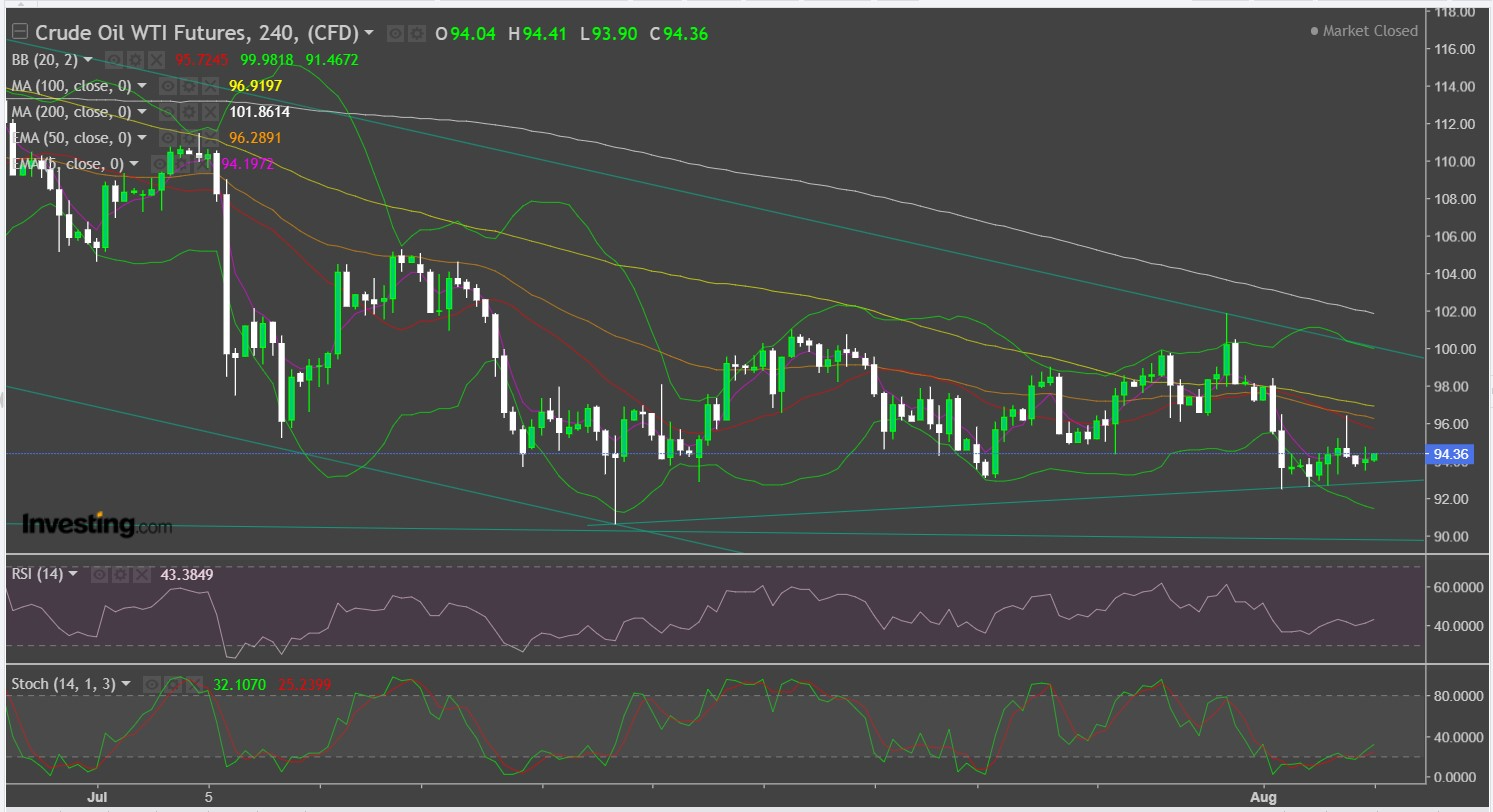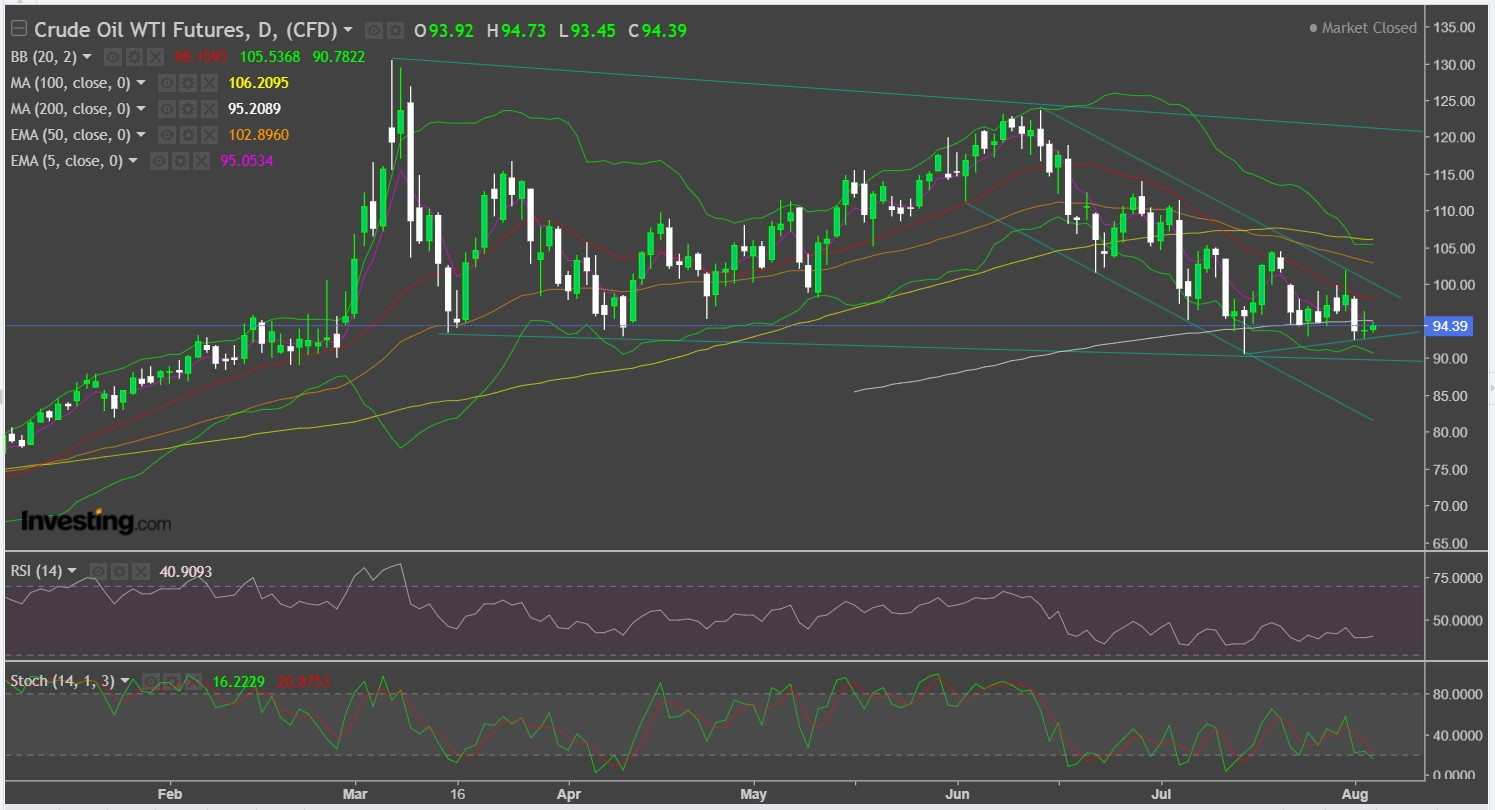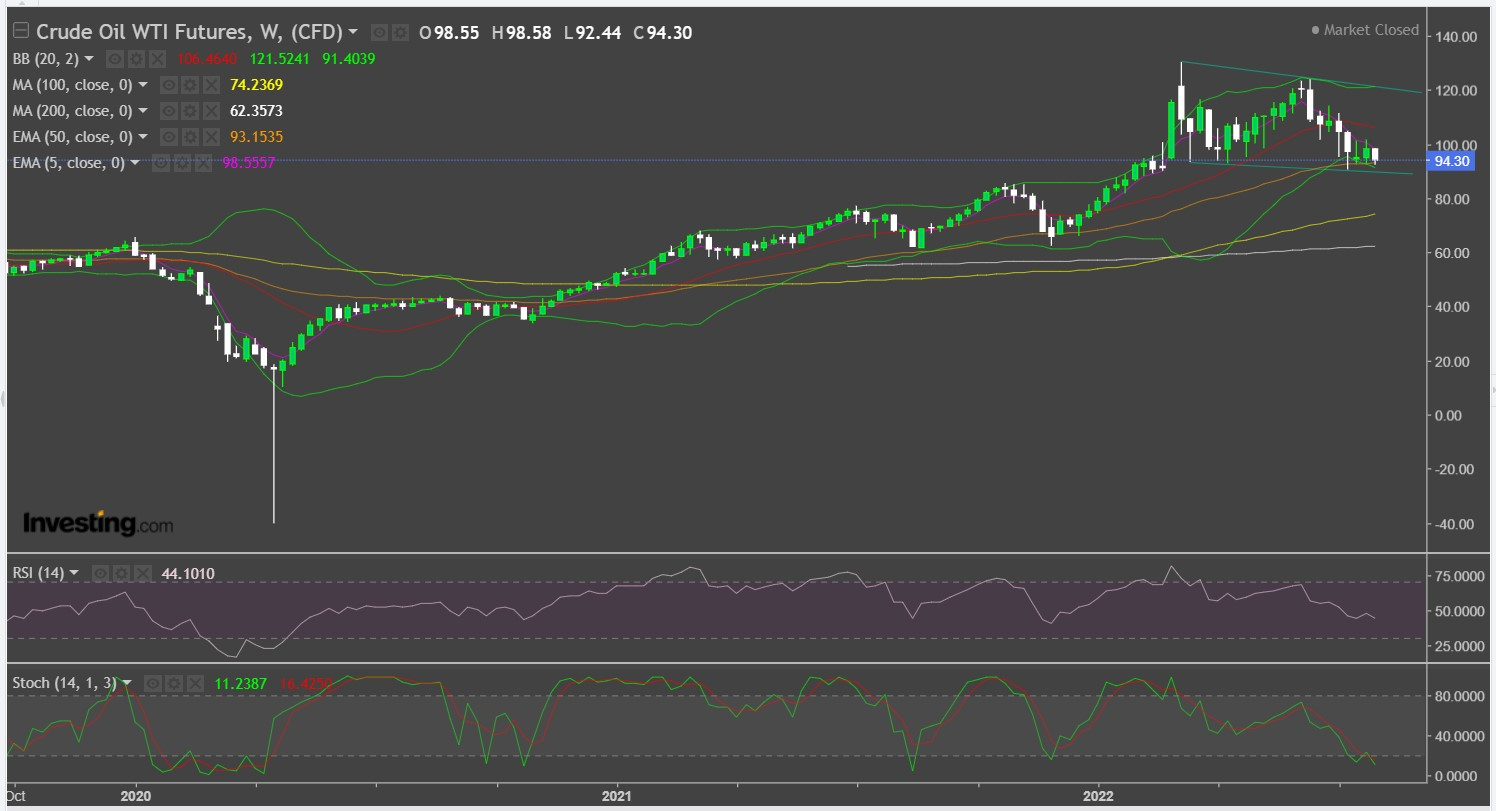- Trade awaits OPEC+ output decision but US jobs report could matter more
- No concession on Fed rate hikes if nonfarm payrolls remain strong
- Higher rates will feed dollar strength, another headwind for oil
- Tenuous hold above $90 could be broken if July/Sept jobs beat forecasts
The oil trade waits with usual trepidation for OPEC+ to announce later today production quotas for the 23 nations in the alliance led by Saudi Arabia—and increasingly influenced by Russia looking for workarounds to the sanctions imposed on it by the West.
But regardless what the original 13 members of the Organization of the Petroleum Exporting Countries and their 10 allies, steered by Russia, decide for production, oil prices might be determined more by the monthly US jobs report due on Friday.
Nonfarm payrolls for July could well decide if US crude remains above $90 per barrel or goes beneath the level it has not seen since Feb. 18.

Charts by skcharting.com, with data powered by Investing.com
There is a clear correlation between oil prices and US jobs numbers—the more people commute to work, the higher the demand for the fuel that will get them around. But the July payrolls report is particularly important for another reason: It could help decide what the next Federal Reserve rate hike will be in September.
After four increases since March that have brought rates from nearly zero to as high as 2.5%, the Fed is nonplussed that inflation, as measured by the Consumer Price Index, hasn’t budged at all from four-decade highs, growing at a pace of 9.1% in the 12 months to June.
Will the next rate hike be another 75 basis points, like in July and June? Or should it be 50 basis points like in May? Or possibly even 25 basis points like in March? The nonfarm payrolls for July—as well as August—will help answer that.
For the first time since April, the Fed will have two back-to-back US monthly employment reports to peruse before deciding on its next rate decision. The July report is scheduled for release on Aug. 5 while next month’s report will see publication by Sept. 2. The Fed’s rate decision itself is on Sept. 21.
Nonfarm payrolls have beaten forecasts for the past three months. For July itself, they're expected to grow by 250,000 jobs over June’s 372,000.
According to John Kilduff, partner at New York energy hedge fund Again Capital:
“Weekly jobless stats have been rising for five weeks now but the monthly jobs report has been surprisingly strong month after month. The good news for markets is that the Fed has an unusually long gap this time—almost two months actually—to study multiple data points before deciding on the September hike. But if the trend for the August and September payrolls doesn’t change much, then expect no major concessions from the Fed on next month’s rate hike.”
“That’s not just bad news for markets in general but also good news for the dollar, which is another negative for oil and other commodities.”
After two straight weeks of declines, the Dollar Index, which pits the greenback against six major currencies, jumped 0.86% on Tuesday, its most in a day since a 1.3% rally on July 5. The session high for the index itself was 106.19. Earlier on Tuesday, the greenback gauge made a near three-week low of 104.92.
The dollar surged in the previous session after Mary Daly and Loretta Mester, Fed chiefs for San Francisco and Cleveland, respectively, said the central bank’s struggle with inflation and high interest rates was far from over.
The greenback also surged as US House Speaker Nancy Pelosi visited Taiwan, sending American-Sino tensions into an overdrive as Beijing fumed over her pro-democratic comments in favor of Taiwan, a country China regards as its territory with no independent sovereignty.
Stephen Innes of SPI Asset Management said the Taiwan jitters induced by Pelosi, as well as the Fed officials’ reaffirmation of their decision to continue hiking rates was still weighing heavily on Wednesday’s markets, including oil. He added:
“Aside from a possible event risk from a shift in OPEC+ production policy when the group meets later, oil traders remain laser-focused on global macro data, particularly concerning the two largest oil-consuming economies in the world, the USA and China.”
US crude fell as much as 5% in the first trading day of this week after data showed Chinese factory activity shrinking in July amid a fresh round of COVID-related lockdowns.
The OPEC+ meeting itself is significant in its own way. It will be the first time the alliance is gathering since unwinding historic cuts of some 10 million barrels per day that it decided in April 2020, in the aftermath of the demand destruction in oil forced by the global coronavirus outbreak that year. In that sense, OPEC+ is at a crossroads where output is concerned.
The alliance had already agreed to bump up production by 50% from June levels to almost 650,000 barrels daily for July and August. That was before President Joseph Biden visited Saudi Arabia last month, raising expectations that the alliance might do more.
As of Tuesday, most oil traders disputed that OPEC+ would want to raise production further in a slowing US economy. Demand-wise, the United States is getting closer and closer to the end of the peak summer driving period, and families are preparing for the new school and college year beginning from mid-August to early September.
The debate over oil consumption aside, a top-level chess game is going on at OPEC+ between Saudi Arabia and Russia on how much to do—or not to—for the United States in terms of production.
Anyone who knows OPEC+ well enough will also know that while the Saudis hold the main levers to the alliance’s production, the chummy relationship between the House of Saud and the Kremlin—particularly between Crown Prince Mohammed bin Salman and Vladimir Putin—should never be ignored.
The Russian president is determined not to let the US gain any advantage from his nation’s war in Ukraine. That includes benefits extended by an oil-producing alliance with Moscow—particularly when the West’s sanctions have already caused heavy discounting in prices of Russian crude, not to mention efforts by Biden to put a cap next on the price of that oil.
As expected, less than a week after Biden’s visit, Putin placed a call to Crown Prince MbS—as the monarch is known by his initials—to remind him of the importance of continued collaboration between the two nations within the OPEC+ spirit.
For further measure, Russian Deputy Prime Minister Alexander Novak met Saudi Arabia's Energy Minister Prince Abdulaziz bin Salman on Friday, after a statement out of Moscow said:
“Russia and Saudi Arabia remain firmly committed to the goals of the OPEC+ agreement to preserve market stability and balance supply and demand in the global oil markets.”
But MbS is in a bit of a delicate spot himself. Having fist-bumped and welcomed Biden, he has opened himself up to at least thawing the cold war that had been running between him and the president, who once vowed to make a pariah of his kingdom for the murder of the Saudi-born-US-resident-turned journalist Jamal Khashoggi, whom the CIA says was killed on the crown prince’s order. The Saudis, of course, deny that allegation.
MbS also wants more emphatic US support for Riyadh in the Yemen conflict. Both the crown prince and his counterpart in the United Arab Emirates, Mohammed bin Zayed Al Nahyan, have been frustrated with Biden’s indifference toward them previously, as well failure to address Gulf concerns about Iran's missile programme and its regional proxies. All that had looked to change promisingly with Biden’s visit.
Among all this drama—US jobs numbers, Fed rate hikes, the dollar’s standing, and OPEC+ production—is the price of oil.
At the time of writing, global crude benchmark Brent was at $100.19 a barrel, down from a June high of above $125 and even further off from the post-Ukraine invasion peak of almost $140 in March.
But the weaker link was the West Texas Intermediate (WTI) hovered at just above $94, down from a June peak of above $123 and a March peak above $130.

Charts show WTI risks falling to as low as $82 if it snaps key support at $93, said Sunil Kumar Dixit, chief technical strategist at skcharting.com.
“A break of the 50-week Exponential Moving Average of $93.16 exposes WTI to the horizontal support areas of $88, $85 and ultimately $82.”
Dixit said WTI was currently on to its third bearish week, with weekly stochastics at 47/55 and the Relative Strength Index having dipped from a previous 73 to 59.

He said a short-term rebound supported by the 50-Week EMA of $93.16 could push WTI towards $96.40 and $98.30.
“A daily and weekly closing above $98.30 can further boost US crude for a retest of the 50-Day EMA of $102.90 and the 100-Day Simple Moving Average of $106.20.”
“But the broader outlook favors a drop towards $88 - $85 - $82 over an extended period of time.”
Disclaimer: Barani Krishnan uses a range of views outside his own to bring diversity to his analysis of any market. For neutrality, he sometimes presents contrarian views and market variables. He does not hold positions in the commodities and securities he writes about.
